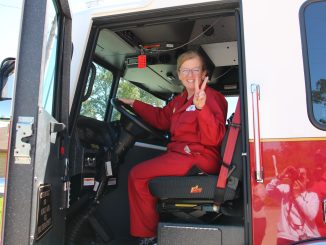
With the recent reopening of the expanded and improved Huey P. Long Bridge, one can take a look back to the bridge’s initial opening nearly 80 years ago in December 1935 and see just how important the bridge has been in the subsequent development of communities in the New Orleans metro area that includes the West Bank of St. Charles Parish.
Since the bridge’s opening the West Bank has grown both in population and industrialization.
The Huey P. Long Bridge was unique by not only providing a way for the relatively new automobile class to travel from East to West Bank, but also providing a stable railroad crossing that could carry heavier loads than the barge bridge near Avondale that carried rail cars across the river previously.
Parish Attorney Leon “Sunny” Vial was just a child when the bridge opened. He was at the opening ceremony and saw the first cars make their way over the bridge.
“At six years old I realized it would stop that long ferry wait,” he said.
Vial said the West Bank was always behind the East Bank industry wise, but after the Huey P. Long Bridge eased access to the East Bank the gap was narrowed.
“It is obvious it helped for commerce especially. Highway 61 wasn’t built yet and Highway 90 was the Old Spanish Trail. It hastened the construction of those highways,” he said. “As commerce could increase and transportation increased not only did the economy get better, but people made more money and more jobs were available.”
Corey Faucheux, economic development director for St. Charles Parish, said the Huey P. Long Bridge was the beginning of a population boom and a later commuter culture in the West Bank.
“In terms of residential development it did provide the commuters that were either living in New Orleans or folks that were in Jefferson Parish’s East Bank that were looking to move and find more acreage to raise their family. The Huey P. made St. Charles a viable option to support them,” he said.
Faucheux said easier access to New Orleans helped the West Bank of St. Charles by providing easier access to the economy of New Orleans.
“It provided additional ingress and egress to the downtown area and at that time New Orleans was one of the leading economic drivers of the south,” he said.
An example of how the bridge changed the lives of those living in the area can be seen in the life of Allen Braud.
At 9 years old, Braud moved from the city of New Orleans to Luling where he has remained for the past 78 years.
In 1934 the now 87-year-old Luling resident’s family made their way to St. Charles Parish only one year before the Huey P. Long Bridge united the West Bank and East Banks and served as the first bridge crossing over the Mississippi River in Louisiana.
He remembers the long waits for ferries he and his family used to take when travelling to New Orleans.
“If you were lucky you could catch it, but most of the time you had to wait and wait and if there was fog you could forget about it,” he said.
At the time, the only ways to cross the river were ferries serving Luling and St. Rose, Ama and Kenner and the two ferries that are still in service connecting Gretna and Algiers to New Orleans.
When traveling back to New Orleans, Braud’s family used the ferries, but he could see the Huey P. Long begin to take shape. By that time the bridge had been under construction for nearly two years.
“Every time we would go that way I would notice something different. I could see it all coming together,” Braud said.
And then in December of 1935 the bridge opened. Braud’s older brother was one of those playing in the Hahnville High School band at the opening celebration.
After that Braud’s life changed. The trips his family took to New Orleans were much more convenient and when he got a little older he began to cross the bridge himself…by bike.
“Me and my friends would get our bikes and ride down Highway 90 and then of course you couldn’t ride your bike up the bridge, at that time we didn’t have the multiple speed bikes. So we had to push them uphill and then ride down the other side,” Braud said.
After a day of swimming in the public pools at New Orleans’ Audubon Park or City Park, Braud and his friends would cross back over and return home to the West Bank.
For many who have crossed the Huey P. in the past few years, it is unthinkable with the small lanes to travel across it by bike or by foot, but back in those days Braud said it was different.
“There wasn’t a lot of traffic at that time and people were more considerate,” he said.
However, that would change over the years with increasing congestion on the bridge.
The bridge would also provide the foundation for the change in Braud’s professional life as well. Although Braud first took a career as a teacher for St. Charles Parish Public Schools after graduating from Hahnville High School and LSU, it was the high wages provided by the Lion Oil fertilizer plant (now Monsanto) that drew him away from his life as a teacher and into industry work.
“I had a growing family and we had to eat!” he said. “It was so bad that I applied for a G.I. home loan and didn’t qualify for it because my income was too low. So I had to take care of that.”
In 1952, within the first year of Braud’s 25-year career at the plant that was built as a direct result of the better transportation provided by the bridge, he built a home he still lives in today on a large lot on the former Ellington Plantation that provided enough space in which to raise his five children.
The area was formerly sugar cane fields, but with the increased need for housing due to the jobs offered by the West Bank it was later subdivided into lots and homes popped up shortly thereafter, changing the face of the growing town. In addition, the attraction of jobs started drawing in others from across the country.
“A bunch of folks from Arkansas moved in here,” Braud said.
According to Braud, the groups embraced one another and the Arkansans quickly assimilated into the Cajun culture.
Many changes were still to come all because of the Huey P. Long Bridge as the West Bank grew over the years and more industry popped up, now supported by easier access to other parts of the state and country. Jobs were created that have helped St. Charles Parish keep it’s moniker as the “Parish of Plenty” and attract more workers from outside the parish who were eager to take part in the local industry.
The construction of the Crescent City Connection in 1955 and the Hale Boggs Bridge in 1983 further helped to connect the West and East Banks, but it was the Huey P. Long that started it all years ago.




Be the first to comment